CRLF2
-
Official Full Name
cytokine receptor-like factor 2 -
Overview
The protein encoded by this gene is a receptor for thymic stromal lymphopoietin (TSLP). Together with the interleukin 7 receptor (IL7R), the encoded protein and TSLP activate STAT3, STAT5, and JAK2 pathways, which control processes such as cell proliferation and development of the hematopoietic system. Two transcript variants encoding different isoforms have been found for this gene. -
Synonyms
CRLF2;cytokine receptor-like factor 2;CRL2;TSLPR;IL-XR;TSLP receptor;P2RY8/CRLF2 fusion;cytokine receptor-like 2;cytokine receptor CRL2 precusor;thymic stromal lymphopoietin receptor;thymic stromal lymphopoietin protein receptor;thymic stromal-
Recombinant Proteins
- Mouse
- Human
- Cynomolgus
- Zebrafish
- Mammalian Cells
- CHO
- C-His
- NS0
- Wheat Germ
- HEK293
- E.coli
- In Vitro Cell Free System
- Fc
- Avi
- GST
- His
- DDK
- Myc
- Non
- Flag
Background
What is CRLF2 Protein?
CRLF2, short for cytokine receptor-like factor 2, is a part of the type I cytokine receptor family and typically acts as a receptor for thymic stromal lymphopoietin (TSLP). When it joins forces with the interleukin 7 receptor (IL7R), it sets off some key signaling pathways like STAT3, STAT5, and JAK2. These pathways are essential for making cells grow and for developing the system that produces blood. In a regular scenario, CRLF2 is vital for B lymphocytes to develop properly. But things can get tricky in acute lymphoblastic leukemia (ALL). Here, CRLF2 might be overexpressed or its gene might rearrange, which is often tied to how the disease starts and progresses. Because of this, CRLF2 has caught the attention of a lot of researchers studying leukemia, as figuring out how it works might unlock new understanding of the disease.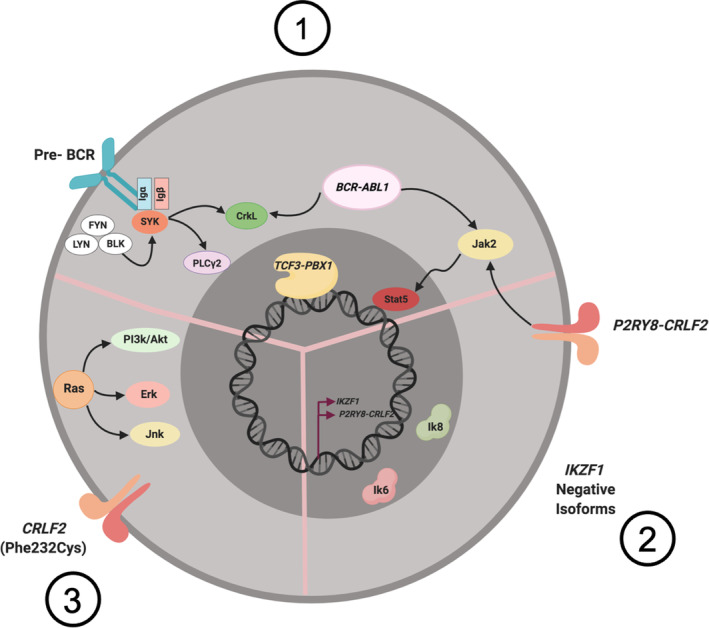
Fig1. Three‐step model of B-cell acute lymphoblastic leukemia (B-ALL) pathogenesis. (Dafné Moreno Lorenzana, 2021)
What is the Function of CRLF2 Protein?
The CRLF2 protein belongs to the type I cytokine receptor family and is mainly recognized as the receptor for thymic stromal lymphopoietin (TSLP). Together with the interleukin 7 receptor (IL7R), it kicks off key pathways like STAT3, STAT5, and JAK2. These pathways are crucial for cell growth and the development of the blood system. In normal situations, CRLF2 is key for B lymphocytes to mature. But in acute lymphoblastic leukemia (ALL), the CRLF2 gene can get rearranged or overexpressed, which is strongly linked to how the disease kicks off and progresses. That's why CRLF2 has caught the eye of many researchers who are digging into leukemia to find fresh insights into this condition.CRLF2 Related Signaling Pathway
The CRLF2 protein teams up with the interleukin 7 receptor (IL7R) to create a dimer complex that fires up the JAK/STAT signaling pathway. This whole process gets going when thymic stromal lymphopoietin (TSLP) binds to CRLF2, helping to activate STAT5 by adding phosphate groups. This activation leads to the transcription of downstream genes, which then influences how cells grow and stay alive. In cases of acute lymphoblastic leukemia (ALL), when CRLF2 is overexpressed or its gene rearranges, the JAK/STAT pathway might become overactive, encouraging leukemia cells to multiply and survive more than usual. Moreover, a mutation in CRLF2 known as Phe232Cys could make the protein form dimers on its own, letting the cells grow without needing cytokines. This makes CRLF2 a crucial focus for researchers looking to understand and treat leukemia.CRLF2 Related Diseases
CRLF2 protein is linked to various diseases, playing a particularly significant role in acute lymphoblastic leukemia (ALL). Its gene rearrangements and overexpression are connected to several types of ALL, including precursor B-cell ALL that isn't high risk and ALL related to Down syndrome. These gene rearrangements often occur alongside mutations in JAK kinases, which lead to abnormal activation of the JAK/STAT signaling pathway. This overactivation encourages leukemia cells to grow and survive more than they normally would. Moreover, abnormal CRLF2 expression is also associated with poor prognosis, suggesting it could be crucial in diagnosing and treating leukemia. Understanding its behavior might lead to better clinical outcomes for patients dealing with this challenging condition.Bioapplications of CRLF2
CRLF2 protein finds applications across research, industry, and clinical studies. In the research world, as part of the type I cytokine receptor family, CRLF2 is key for studying its role in acute lymphoblastic leukemia (ALL). It's especially interesting in cases like Ph-like ALL, where rearrangements in CRLF2 lead to high expression on the cell surface, promoting the growth of precursor B lymphocytes. When it comes to industrial production, recombinant CRLF2 protein and its antibodies are used in developing experimental reagents and other research tools. Clinically, CRLF2's high expression levels are linked to poor outcomes, making it a potential biomarker for various cancers. Techniques like flow cytometry and PCR that measure CRLF2 expression are also utilized to detect blood-related diseases, highlighting its significance in medical diagnostics and treatments.Case Study
Case Study 1: Gu M. et al. Int J Lab Hematol. 2021
Researchers explored how different abnormalities in the CRLF2 gene (such as CRLF2, CRLF2 + IK6, P2RY8-CRLF2, and CRLF2 F232C) affect and function in the Nalm6 B cell ALL line. They used a cell counting kit-8 to assess cell growth, while RNA-seq allowed them to observe changes in gene expression with various CRLF2 anomalies. They also conducted drug sensitivity tests. All four abnormalities led to increased CRLF2 levels and promoted the growth of Nalm6 cells. RNA-seq indicated an increase in JAK/STAT pathway genes and a decrease in cell cycle-related genes in CRLF2 F232C-overexpressing cells. Western blotting showed elevated p-STAT5 protein in these cells. Researchers found that cells with CRLF2 abnormalities resisted cyclophosphamide and standard treatment drugs more effectively than the vector group. Specifically, CRLF2 F232C cells displayed higher IC50 values for dexamethasone.-
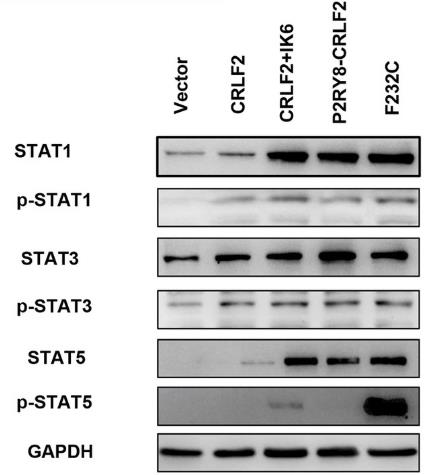 Fig1. Protein expression in the JAK/STAT pathway in the CRLF2-, CRLF2 + IK6-, P2RY8-CRLF2- and CRLF2-F232C-transfected Nalm6 cells.
Fig1. Protein expression in the JAK/STAT pathway in the CRLF2-, CRLF2 + IK6-, P2RY8-CRLF2- and CRLF2-F232C-transfected Nalm6 cells. -
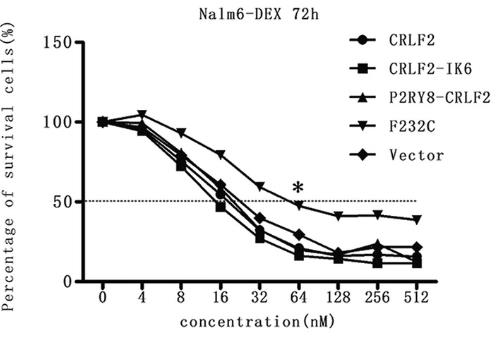 Fig2. Drug sensitivities towards DEX in the Nalm6 cell lines with CRLF2, CRLF2 + IK6, P2RY8-CRLF2 and CRLF2 F232C overexpression.
Fig2. Drug sensitivities towards DEX in the Nalm6 cell lines with CRLF2, CRLF2 + IK6, P2RY8-CRLF2 and CRLF2 F232C overexpression.
Case Study 2: Jiang M. et al. Oncol Rep. 2019
Acute B-cell lymphoblastic leukemia (B-ALL) is a prevalent type of blood cancer linked to abnormal gene activity. CRLF2 plays a key role in immune cells like dendritic cells and T cells. The study examined if blocking the CRLF2-mediated AKT/mTOR pathway could be a viable treatment and prognosis approach in B-ALL. Researchers gathered bone marrow samples from children with B-ALL and healthy ones, measuring CRLF2 levels via immunohistochemistry and comparing survival outcomes. In experiments with BaF3 leukemia cells, CRLF2 was silenced and treated with an AKT/mTOR inhibitor. They then looked at mRNA and protein changes using RT-qPCR and western blotting. They checked how well the cells survived using a Cell Counting Kit-8, studied cell movement and invasion with various assays, and used flow cytometry to see how sensitive the cells were to the drug imatinib.-
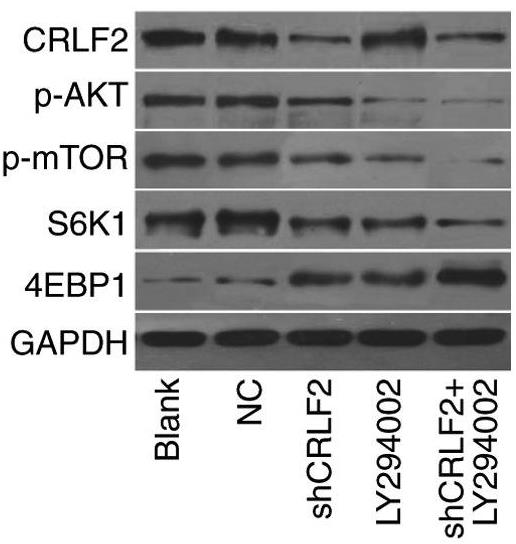 Fig3. Reverse transcription-quantitative polymerase chain reaction and western blotting results in each group.
Fig3. Reverse transcription-quantitative polymerase chain reaction and western blotting results in each group. -
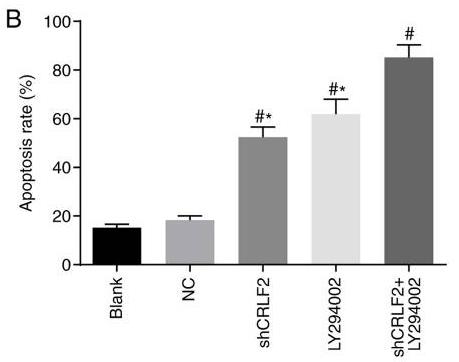 Fig4. BaF3 cell sensitivity to chemotherapeutic agents.
Fig4. BaF3 cell sensitivity to chemotherapeutic agents.
Quality Guarantee
High Purity
-
.jpg) Fig1. SDS-PAGE (CRLF2-30H)
Fig1. SDS-PAGE (CRLF2-30H)
High Bioactivity
-
.jpg) Fig2. Activity Data (CRLF2-29H)
Fig2. Activity Data (CRLF2-29H)
Involved Pathway
CRLF2 involved in several pathways and played different roles in them. We selected most pathways CRLF2 participated on our site, such as Cytokine-cytokine receptor interaction,Jak-STAT signaling pathway, which may be useful for your reference. Also, other proteins which involved in the same pathway with CRLF2 were listed below. Creative BioMart supplied nearly all the proteins listed, you can search them on our site.
| Pathway Name | Pathway Related Protein |
|---|---|
| Jak-STAT signaling pathway | IL6,HRASA,OSM,SOCS1,TSLP,PRL,AOX2P,IFNPHI3,SOCS9,IFNAR1 |
| Cytokine-cytokine receptor interaction | TNFRSF9A,GHRA,IL13,LEP,XCL2,IL18RAP,TNFSF8,IFNK,TNFSF12,IL6R |
-
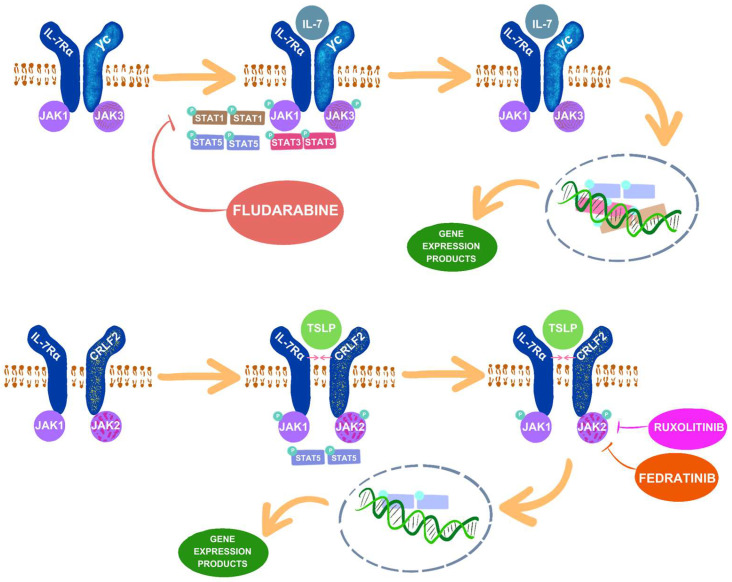 Fig1. Effects of IL-7 and TLSP on the JAK–STAT signaling pathway and the action of selected inhibitors of pathway components. (Karolina Joanna Ziętara, 2024)
Fig1. Effects of IL-7 and TLSP on the JAK–STAT signaling pathway and the action of selected inhibitors of pathway components. (Karolina Joanna Ziętara, 2024) -
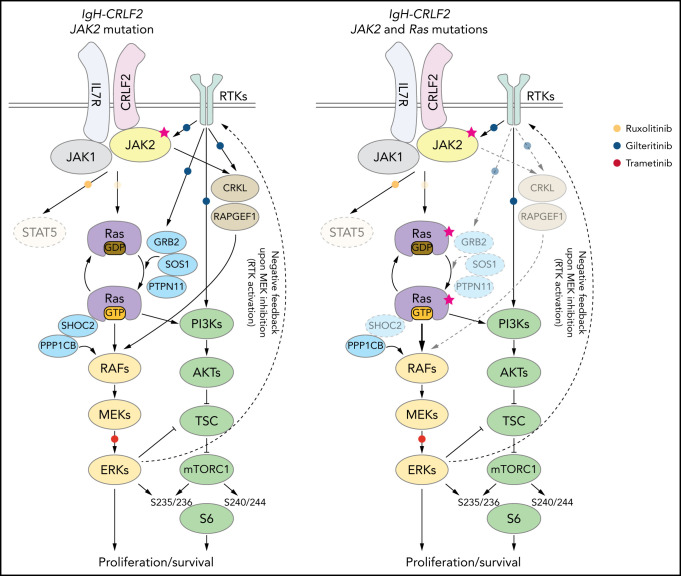 Fig2. Proposed model of signaling pathways relevant to RAS-WT or RAS -mutated IgH-CRLF2-r ALL cells. (Kensuke Sasaki, 2022)
Fig2. Proposed model of signaling pathways relevant to RAS-WT or RAS -mutated IgH-CRLF2-r ALL cells. (Kensuke Sasaki, 2022)
Protein Function
CRLF2 has several biochemical functions, for example, . Some of the functions are cooperated with other proteins, some of the functions could acted by CRLF2 itself. We selected most functions CRLF2 had, and list some proteins which have the same functions with CRLF2. You can find most of the proteins on our site.
| Function | Related Protein |
|---|
Interacting Protein
CRLF2 has direct interactions with proteins and molecules. Those interactions were detected by several methods such as yeast two hybrid, co-IP, pull-down and so on. We selected proteins and molecules interacted with CRLF2 here. Most of them are supplied by our site. Hope this information will be useful for your research of CRLF2.
Resources
Related Services
Related Products
References


